Tell us about your approach to photography. How it all started? What are your memories of your first shots?
Gianfranco Gallucci (GG): I’m a self-taught photographer and I started taking photos when i was at university. I studied architecture, but my entire path has been influenced by a lot of other things during those years. Besides, I knew almost from the beginning, that I would never become an architect, I didn’t want to be an architect, I knew it wouldn’t have been my path, but these studies allowed me to wide open my mind and “touching” and develop a deep sense of the underneath “structure” of the world around. The word Architecture means for me a lot of things and that’s what makes it great, it’s the physical mirror of our time and our society, or at least that’s how it should be, but I almost immediately understood that I was interested more in describing and narrating the world around me, rather then contributing to modifying it, or worse, to spoiling it, as sometimes happens. When I was at the high school I was interested and have practiced a lot of things, most of all, playing music, performing in a theater and a great passion for cinema. So in the first years of my architecture studies I approached to cinema, studying direction and film editing, while acting in a theater company. All the things I was doing or studying at that moment were mixed and influenced each other.
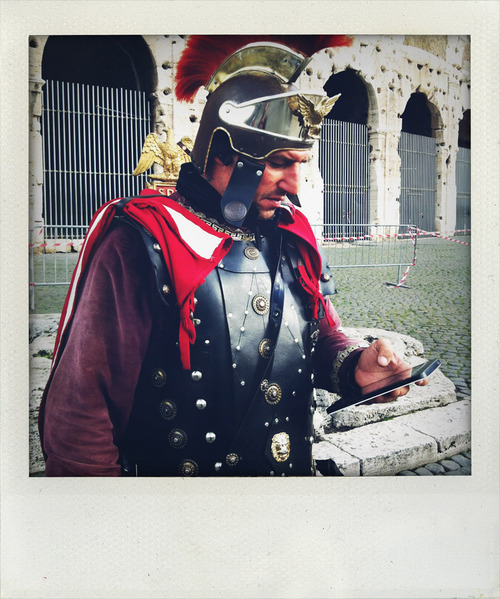
© Gianfranco Gallucci ‘Colosseo’ from the series ROMApolaroids
Since I was going to buy a movie camera I started to approach to photography by chance, maybe thinking to better understand the moving image and, when it happened, it was unforgettable. In these things, when you approach a medium (meaning a language to say something) there’s never a precise starting moment, it happens! That’s all (maybe it starts unconsciously inside you much more before) and in a few minutes you’re totally immersed in a virtual place that you recognize as yours and confortable enough to allow you to tell what you want to talk about. The most fascinating thing is that it’s a continuous search and dialogue, between yourself, your thoughts and ideas, “the language you talk” (photography, that you’ve chosen and that you continuously learn in a way) and all the things around you. But if I should remember a sort of starting point, it was an entire winter night, spent in my house in Ferrara, smoking at the window of my kitchen, taking pictures of the landscape outside, with one of the first digital cameras, during a rare snow, listening to Arvo Part’s album “Tabula Rasa”, getting down in a sort of trance.

© Gianfranco Gallucci ‘Porta Maggiore’ from the series ROMApolaroids
And if I think to those early pictures, they make me laughing, but it’s fine to remember. After that, I started going outside by night while everyone was asleep and, walking around the city, I used to take pictures of roads, buildings and more, in the suburbs and in the centre, with black and white film. I also remember pleasantly, the several nights spent in the south of italy in the two towns of my parents taking pictures of places so different, yet much more familiar, from the one where i’ve grown up, in the north.

© Gianfranco Gallucci ‘Roma KO’ from the series ROMApolaroids
The last years of university were spent to pass exams rapidly, dedicating completely the rest of my time to photography, getting down more and more deeply inside this world, reading, studying, looking at masters, and learning alone with a sort of fire inside and with the clear awareness of what i wanted to do in my life. At the end, I think I’m really lucky to have studied architecture, it hasn’t been a waste of time, as it could seem, it’s never a waste of time… Everything you do, it remains inside you and becomes a precious “enrichment” that comes out every time you do something else, cause everything is profoundly connected, as the things you’ve done and the people you met, as also those of the future. Everything always comes back, as in a sort of endless circle… and of a circus also!
How did your research evolve with respect to those early days?
GG: Lots of things are changed since then. I’ve grown up, first of all as a person (I was 23), and photography grows with you, it’s your language… So it changes with you. You add the experiences you live in your time. It’s a discover, a beatiful trip along your life. For me it’s a love and hate relationship with photography. Sometimes it happens that I think to have nothing to say or that photography seems to me so useless, but it’s also an addiction, I’m never fed up of her. I think that photography brought me to develop a way to look around, but this can be also a sort of filter or limit…
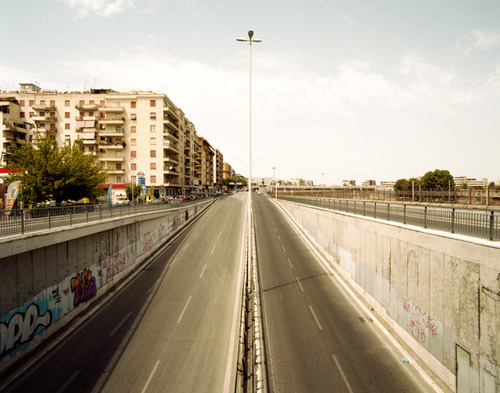
© Gianfranco Gallucci from the series ‘Circonvallazione Nomentana’
Being the language you use to communicate, it becomes also the medium through which you express your point of view (in all senses..) and so sometimes it can be constraining to me, I don’t know, it’s just a thought. If I should compare my first shots and so my first photography (language), maybe it was less complex and rich of meaning, but full of a raw genuinity; maybe a bit naive, but purer in a way, respect to the present, after having developed more familiarity with the medium and the language.
I approached to photography essentially for the love I have for life, in all its aspects and for my desire to record and narrate it. During these years I realized that the best way, closer to me, to do it, was through the visual power of places and their inner nature. Using places to tell what there’s inside them, what’s happened in a place and the traces left, the history and the stories, the document, sometimes the absence of a past’s presence, people who lived, enjoyed, suffered and dead in that place, but also social documentation of the people who live, enjoy, suffer and will dead in that place today and in the future.
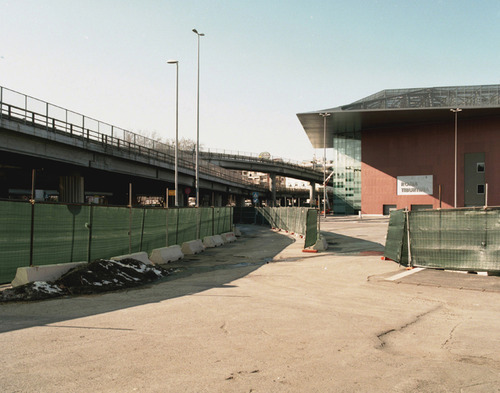
© Gianfranco Gallucci from the series ‘Circonvallazione Nomentana’
I believe that all this is secretely kept inside a place. My job, my pleasure, is try to “read” that place (no matter which one) and give back a visual feedback of my interaction with it. So, even if the research is always going on, the main step that i reached till now, is having understood better, what and also maybe how, telling my subjects and stories. -Even if, every time is such a mess, a nebulous in your mind that becomes clear just while you get down inside each story. - Another thing I started lately, is taking less photos, and on each photo, trying to apply every time a sort of zen practice of deleting and cleaning, reducing in order to simplify and so reaching the inner core. But I’m still practicing to improve always… Till it becomes totally natural, without thinking.
Tell us about your educational path. Bachelor degree in Architecture, FAF, Ferrara, and then you got a master in photojournalism at ISFCI in Rome. What are your best memories of your studies. What was your relationship with photography at that time?
GG: If I look back I see my years at university (as i already told above), my months in Paris with the internship at VU’, and after that, the master in photojournalism at ISFCI during my first year in Rome, where I still live. Ten years, quite enough. I met a lot of people and everyone have taught me something, even if sometimes I understood it later. I think mainly they were educational and growing years for me, full of many bad and good experiences, and I’m thankful about that. Maybe this is also the reason why my website could seem more a sort of diary of these ten years of various experiences, as it was a sort of house, where you can come to visit me. I like considering a website as a place where you can have the pleasure to go spontaneously and visit it, as when you go to visit a friend.

© Gianfranco Gallucci from the series ‘Circonvallazione Nomentana’
I remember that my last years at university were spent to finishing it as soon as possible, in order to vote myself completely to photography, a sort of transition, as when you die and you pass over, with its gateway represented by my thesis, that was deliberately a mix between before and after, my studies on the territory and planning and photography. I worked on it for two years, formulating a method for the sistematic introduction of urban and landscape photography in the analisys of metropolitan areas and interstitial territories between, titled “PHOTO(+)DATA backup – A feedback for the contemporary city” and “tested” on the parisian suburbs. After that, I won a european scholarship that allowed me to attend an internship at GalerieVU’ (AgenceVU’) in Paris in the first months of 2009. It’s been important for my education, I really had the possibility to learn so much there.

© Gianfranco Gallucci from the series ‘Circonvallazione Nomentana’
At the beginning, when I realized that I would have worked in a gallery I was a little bit disappointed, because I would rather preferred to work in the agency. But after this experience I’m so thankful to have attended the internship in the gallery instead of the agency. I understood that I would have learnt a lot of other aspects about photography, how to present and show your work, about exhibitions, the relationship of an author with a gallery, etc., etc., that are things so important and that in some way I had neglected till then. Besides, I’m sure that the “gallery approach” influenced me very much, not just for all the great authors and persons who work inside that I met, but for my approach to photography that it’s usually quite far from “news approach” or assault photoreporter, having however a documentary and narrative approach. I think that all the different authors that I personally met or just known by their work, represented by the gallery, deeply influenced me about this.
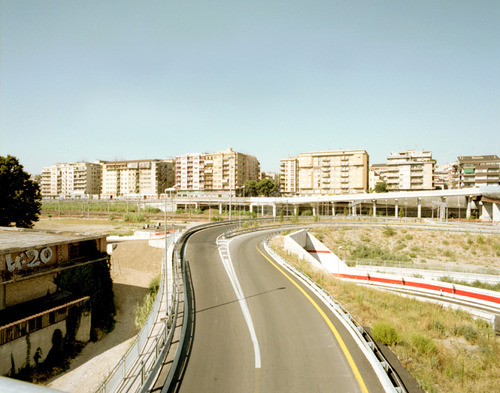
© Gianfranco Gallucci from the series ‘Circonvallazione Nomentana’
After that, I came back in Italy and the following year I moved to Rome. I had always learnt everything about photography alone, making mistakes and trying again and again in a sort of sick positive addiction. I was approaching to photography, I was trying to understand what it was and trying to understand why I was doing it and what I wanted to do with her, and she was so fascinating and seducing. But when I was in Paris I started thinking that I needed a wall to face, something concrete to “test” the nebulous i had produced till then, most of all, after the total immersion in Paris. I’ve never loved institutions and schools, etc. fundamentally because I think that photography is something personal and intimate in some way, not teachable and not learnable. I mean, photography is a language and you need to learn grammar, but it’s something you can do easily alone studying and taking photographs, but the rest is not teachable. I know it’s a delicate statement… but it’s my opinion.
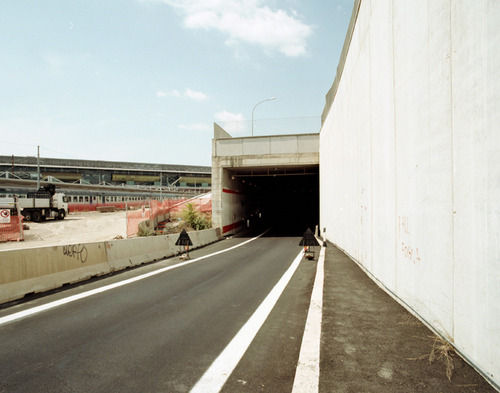
© Gianfranco Gallucci from the series ‘Circonvallazione Nomentana’
I don’t wanto to say that schools are totally “useless”, but maybe for other things as important as a good education of the sight, to learn reading other’s work and learn from past experiences in that field, and mainly as in my case, to learn about all the dynamics inside this job, that you make yours, completely just when you live them on your own skin, once you start working. Probably this was the main reason that brought me to wish attending the master and at the end I can say it’s been a really important experience in general, also for growing up.
What were the courses that you were passionate about and which have remained meaningful for you?
GG: I remember that when I was younger I didn’t like to much studying, I started become fond of knowledge and I discovered the importance of studying in order to have a wide culture and develop a personal point of view about life and everything else, only in the last years of the high school. I was passionate in geography, philosophy, and some others. I studied music and classic guitar at the conservatory, and at university I liked most, planning, territory analisys, representation techniques, story of architecture and some others. But since when i was at the high school, the most exciting thing was discovering the outstanding interconnection that is present between all the subjects, and that I would later enhanced completely, studying architecture at university and trying to catch the inner untouchable structure of the world around me.
Any professor or teacher that has allowed you to better understand your work?
GG: Since I started to approach to photography I received a lot of precious suggestions and teachings. Often, to the memory of each person has associated a single, even little, teaching. Also with those persons who are not of the field, common persons that I met on my path, as during exhibitions or showing my works and not only. For me it’s fundamental and more precious the feedback of an external person that doesn’t “understand” about photography, because in many cases this one has a totally different and “fresh” opinion to give you about your work, as if, in a way, it was more real and linked to the reality of life, and so, far from the complexity of those in the know, that it’s useful alike.

© Dario Coletti, Miniera, Sardegna
The best teacher to better understand my work has been surely all the experiences I lived. Other kind of teachers have been all the works of photographers I saw, the novels I read, the movies I watched, the music I listened to, and then painters, sculptors and so on… But it’s fundamental the role of some persons, as some great authors and professionals that i had the pleasure to meet at VU’ and not only. I had a good teacher at the school of photojournalism, Dario Coletti, but I understood it later, unconsciously applying today some of his little teachings that at the time I considered not too important and that now I found so precious in their simplicity.

© Dario Coletti, Miniera, Sardegna
And another one was a young professor at university, Gaia Magoni, that, even if didn’t allow me to better understand my work because of my beginning, “simply” believed in me, maybe glimpsing something good!
You’ve participated as well to workshops, with photographers like Patrick Zachmann, Davide Monteleone and Christina Garcia Rodero. Tell us about these experiences in general and how they affect your personal research.
GG: When you learn or experience something, it happens quite often to have the feeling of not having learnt anything new, apart from some stuff, cause when you hear talking about photography it seems always to hear something already heard and common to everyone. That’s what usually happens to me in these cases. But nothing wrongest probably. I mean, after some time you find out that you learnt a lot instead. Apart from the sensitive enthusiasm and involvment for her work, received by the Person of Cristina Garcia Rodero, the two workshop that I most appreciated and that influenced me more, have been the one with Patrick Zachmann and the other with Davide Monteleone, whose work really hits me a lot, and to which I find closer in terms of approach even if different for the subjects’ choice.
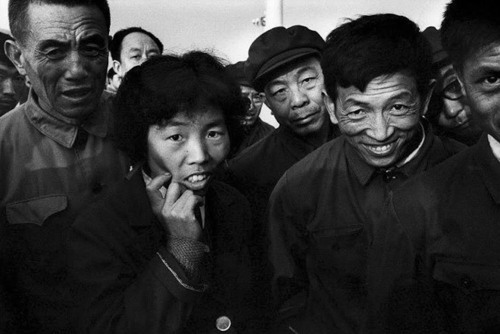
© Patrick Zachmann
I probably learnt how to deal with, and better manage, the subject of a project. As concerning Zachmann, immigration, a theme really beloved to me, son of immigrants from the south of Italy, born and grown up in the north. In fact, I then worked on this issue, with a long project, started in 2010 and that I’m going to conclude at the moment, about the immigration phenomena in the city of Rome. With Monteleone instead, there was a different approach, also because of the generation, apart from being them two different persons. I learnt a lot simply looking at his personal way to deal with things that probably brought him to define his distinguishing mark.
Of these workshops what hit you from the point of view of methodology and what would you improve or deepen?
GG: As above, when you have to deal with great authors, their works simply instill something strong and coherent inside you. For both, the main teaching I received from them has been a question of approach, even if differents. And the importance of attending a workshop I think is included in the word confrontation that becomes the main aspect on which you work on and from which you learn most, from the point of view of human and professional, with the author, with others and with yourself. So if I should suggest something, probably this could be my belief that a real workshop is the place of a special meeting based on the idea of encounter and positive clash, where everyone has its personal contribution and where also the author can learn something from the others. I think that’s the ideal workshop, so i’ve been quite lucky I think.
About your work now. How would you described your personal research in general?
GG: I can say I pacified inside me, partially, the demon of photography! Jokes aside… I mean that when I started, in a short, photography for me has become a real obsession and my whole life revolved around it. Now I can say in this sense, that it became a “simple” powerful tool, or better, a real language to tell of things, with more consciousness, so now I worry more to live, actually.
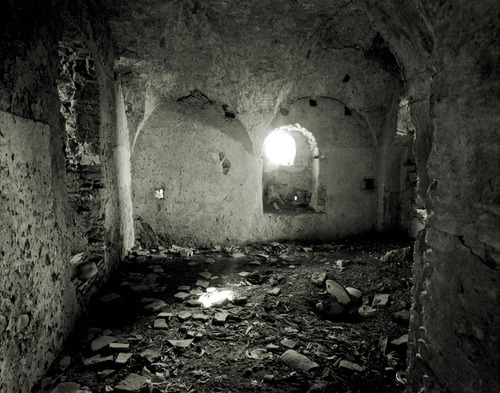
© Gianfranco Gallucci from the series ‘Craco un paese’
Yet the first few times, I remember the excitement that I simply felt every time I took the camera in my hands, or I was in a place that I felt it was asking me to be photographed, there was nothing else, I was totally excited! I do not mean that the focus was only on the medium, but somehow, being completely new to the act of taking photographs, I was totally absorbed in living it and enjoying it; as if the reason of taking those pictures, so even the approach and the subject, didn’t interest me too much. This is also perhaps the reason for such an experimentation in the beginning, both in order to learn how to photograph technically (which I’ve never been much interested in, actually), and to see where I could push myself physically and not, with photography.

© Gianfranco Gallucci from the series ‘Craco un paese’
Today certainly things have changed and my attention and interest to the subject, the way of approaching it and talking about it, is much stronger, but maybe that’s a common process… Don’t know, this was mine. When you approach a medium, you’re only instinct, later, you understand that you need some methodology, no matter what (each one has his own), in order to work or realize a project. At the end it becomes a sort of mix between instinct and methodology, that probably goes under the name of experience. In these last years, I’m discovering the reason of my subjects, or at least the main ones, and how to approach them, even without thinking too much about it, but i’m surely becoming more aware of what I do. I’m defining more clearly my path. Or the path itself is better showing to me. I understood for example, looking at me and my life, that probably the reason of my attachment and big interest about places is linked to my past studies for sure, but also most for the fact to be born and grown up in a land that was not the one of my parents and that I’ve never recognized as mine or of my family, even if it has influenced me a lot anyway.

© Gianfranco Gallucci from the series ‘Craco un paese’
I feel my strongest origins are in the South of Italy, in the lands of my parents, but I feel I’ve got no homeland in a way, or I’ve got many. So every time I experience a place, I look for something, and through this, I try to tell something about that place. But at same time, places are never the final aim of my search, somehow, I use them as an instrument, to tell stories, or events, past and present, and others. I think that a place is like the “black box” of a plane that records everything, or a book that you have to read and then asking yourself the questions you want. That’s what I would develop in the next. I wish i became a good author, to have the honour and the pleasure to witness our time in order to let the people thinking about the things we live and that should interest all of us. Probably this is my challange..try to do this, taking pictures of places.
Do you have any preferences in terms of cameras and format?
I like using a lot of different cameras and changing everytime approach. Digital, analogue, smartphone, I don’t think, in a way, it’s so important the camera you use… it’s just like a pen to write. I know, every instrument has its own peculiarities and it represents somehow a kind of particular “sight”, but at the end, I decide each time which one is the best for me and for what and how i want to tell that subject. Probably if I should say the one I feel closest to me at the moment, and that effectively I use most, it’s the medium format 6x7, often with a tripod.
Tell us about ‘Circonvallazione Nomentana’...
'Circonvallazione Nomentana' arises from a commission, received last year by the gallery who represents me. It’s a documentary project where I decided to talk about the Nomentano district through one of its distinctive element. Documenting the current status of Nomentano district (one of the Capital districts), the attention focused on a border element, “Circonvallazione Nomentana”, an arterial road (part of an inner beltway of the Capital) that represents one of his boundaries. This, gave me the opportunity to report some aspects and issues related to these kind of hidden uncommon places that originates across the infrastructure.

© Gianfranco Gallucci from the series ‘Circonvallazione Nomentana’
I considered this stretch of road as the “spine” of the territory in which I photographed, as it was a real river (but a concrete one..) along which I walked, finding on its banks every kind of element, across signs left by human presence, to the wild action of nature that tries to respond to the presence of the infrastructure and many other things that compose the scenario of this district part and also partially of the Capital itself. The selected area starts from “Tiburtina street” and its road junction, continues along the arterial road of the circonvallazione nomentana and ends with the flyover of “Via Nomentana”, under which, the arterial road changes its denomination in Circonvallazione Salaria.
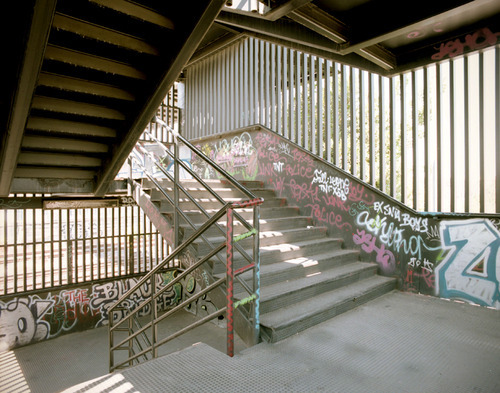
© Gianfranco Gallucci from the series ‘Circonvallazione Nomentana’
These places evoke the idea of the flowing time through their temporary nature, underlined by the subjects depicted, as the precarious dwellings built by clandestines, the status of a road, the landscape of a pedestrian zone, the temporary presence of elements met there in that moment, to testify about their presence even just for a while, to create the image of the places I described with the early total certainty of finding them different a second later. And even the “river” itself, and not just its banks, has lived this continuous change, as results from its still open road-yard.
Is there any contemporary artist or photographer, even if young and emerging, that influenced you in some way?
If I should think to a possible answer, I could say a sort of unique weird monster made up of many photographers… lol… Anyway, lately, probably Alec Soth most… but I also have lot esteem of others as, Davide Monteleone, Joakim Eskildsen, Todd Hido. But if I should think of the beginning, the imprinting has been surely by Stephen Shore and all New Topographics group, Walker Evans, Joel Sternfeld, the School of Dusseldorf photographers, Gabriele Basilico, all Magnum authors and the main american photographers, as Robert Frank first, Eggleston, Winogrand and so on… I “met” italians, those mainly working on landscape, and french, only later… but with an extraordinary lesson.
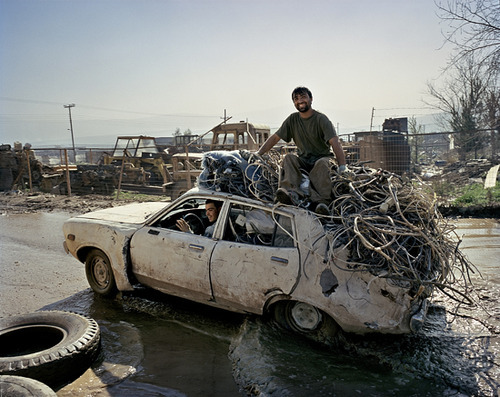
© Joakim Eskildsen, The Cable Car, Nea Zoi, from the series The Roma Journeys
I remember when I used to study philosophy at the high school, every time I faced a new philosopher, it was the discovery of a new world and a new point of view. Probably the same thing happens each time I’m influenced by a specific author, photographer or other. At the end, you keep just a few things from them, the rest is yours and you go on.
Three books of photography that you recommend?
GG: Hard to tell… I love photo books, I’ve got many that are very special to me. Maybe one who has deeply influenced me is Uncommon Places by Stephen Shore. For the other two Sleeping by the Mississippi by Alec Soth and The Roma Journeys by Joakim Eskildsen. I add The Nature of Photographs by Stephen Shore, as “bonus track”! ;) But actually could follow a very long list..
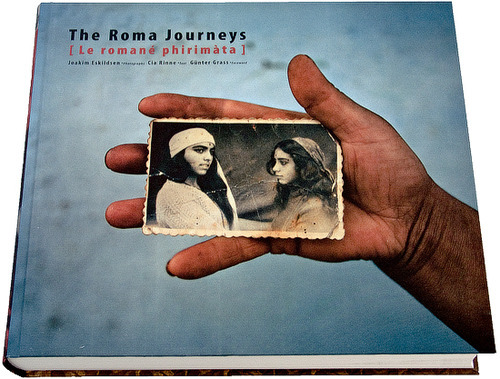
Is there any show you’ve seen recently that you find inspiring?
GG: The last two exhibitions I’ve seen recently are, one about the work of Luigi Ghirri, at Museo MAXXI, and the other one on Helmut Newton, at Palazzo delle Esposizioni. Both gorgeous! But the last exhibitions I really found inspiring, has been a big retrospective on Edward Hopper at Fondazione Roma Museo some years ago, and Alec Soth “Portraits” at the American Academy in Rome. But at the end everything can be a show everyday… and so a potential source of inspiration, it depends from yourself.
Projects that you are working on now and plans for the future?
GG: At the moment I’m working on a couple of projects. The one I’m going to finish is about immigration in Rome, started in 2010, titled You’re Welcome, where I tell the personal story of common people who left their country to move here, trying to find a better life. There are contextualized portraits, landscapes pictures and video interviews. The other one, Craco, un paese, is a project I’m working on (it’s still on going actually)… editing it, but probably it will be integrated by other elements in the next future. It’s a work realized on the ghost town of Craco in the south of Basilicata and it’s a work that belongs to a wider personal project about my origins. Besides, I’m working on the editorial project for the work ROMApolaroids, of which I’m thinking of realizing a book, and so I’m looking for an editor to publish it.
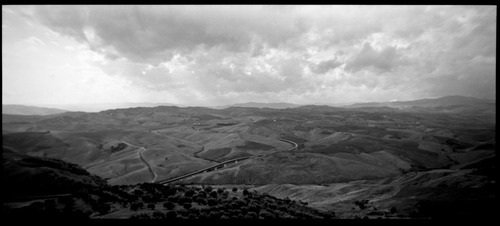
© Gianfranco Gallucci from the series ‘Craco un paese’
Plans for the future… I’m cooperating with a writer to realize a project on the theme of abandoned villages in Italy; I’m editing quite old works (still waiting for coming to light) and I’m considering the idea to move somewhere else in order to change zone, and themes, to work on with new projects. In addition, I’d like in the future having the possibility to cooperate with some good photo agency, even if working only as a freelance has its own advantages, because I think that facing that kind of “reality” could be professionally stimulating and a great chance for learning new things.
---
LINKS
Gianfranco Gallucci
Italy
share this page